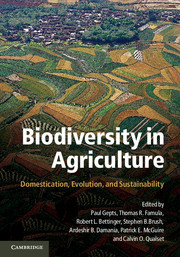Book contents
- Frontmatter
- Contents
- Tables
- Figures
- Foreword
- Contributors
- Acknowledgments
- Introduction: The Domestication of Plants and Animals: Ten Unanswered Questions
- 1 The Local Origins of Domestication
- Section I Early Steps in Agricultural Domestication
- Section II Domestication of Animals and Impacts on Humans
- Section III Issues in Plant Domestication
- Section IV Traditional Management of Biodiversity
- Section V Uses of Biodiversity and New and Future Domestications
- Index
Section III - Issues in Plant Domestication
Published online by Cambridge University Press: 05 June 2012
- Frontmatter
- Contents
- Tables
- Figures
- Foreword
- Contributors
- Acknowledgments
- Introduction: The Domestication of Plants and Animals: Ten Unanswered Questions
- 1 The Local Origins of Domestication
- Section I Early Steps in Agricultural Domestication
- Section II Domestication of Animals and Impacts on Humans
- Section III Issues in Plant Domestication
- Section IV Traditional Management of Biodiversity
- Section V Uses of Biodiversity and New and Future Domestications
- Index
Summary
Issues in Plant Domestication
The four contributions in this section illustrate the domestication continuum across time and space. While domestication started in specific areas (variously called centers of agricultural origins or domestication or even Vavilovian centers), it is now conducted outside these original areas as well. Likewise, domestication started roughly 10,000 years ago in association with the end of the last ice age, and is still practiced today by farmers and breeders. Each stage and location of agricultural development represents potentially different evolutionary factors that can shape the domesticated gene pools. Dissemination from the original hearths of agriculture undoubtedly brought into the picture factors such as selection for adaptation to new environments as well as genetic drift due to small sample sizes. Different cultivation areas also reflect different human cultural environments and, hence, distinct cultivation and consumption requirements.
- Type
- Chapter
- Information
- Biodiversity in AgricultureDomestication, Evolution, and Sustainability, pp. 309 - 310Publisher: Cambridge University PressPrint publication year: 2012



